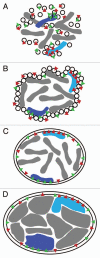The nuclear envelope as a chromatin organizer
- PMID: 21970986
- PMCID: PMC3322583
- DOI: 10.4161/nucl.2.5.17846
The nuclear envelope as a chromatin organizer
Abstract
In the past 15 years our perception of nuclear envelope function has evolved perhaps nearly as much as the nuclear envelope itself evolved in the last 3 billion years. Historically viewed as little more than a diffusion barrier between the cytoplasm and the nucleoplasm, the nuclear envelope is now known to have roles in the cell cycle, cytoskeletal stability and cell migration, genome architecture, epigenetics, regulation of transcription, splicing, and DNA replication. Here we will review both what is known and what is speculated about the role of the nuclear envelope in genome organization, particularly with respect to the positioning and repositioning of genes and chromosomes within the nucleus during differentiation.
Figures






References
-
- Callan HG, Tomlin SG. Experimental studies on amphibian oocyte nuclei. I. Investigation of the structure of the nuclear membrane by means of the electron microscope. Proc R Soc Lond B Biol Sci. 1950;137:367–378. - PubMed
-
- Suntharalingam M, Wente SR. Peering through the pore: nuclear pore complex structure, assembly and function. Dev Cell. 2003;4:775–789. - PubMed
-
- Schirmer EC, Foisner R. Proteins that associate with lamins: many faces, many functions. Exp Cell Res. 2007;313:2167–2179. - PubMed
Publication types
MeSH terms
Substances
Grants and funding
LinkOut - more resources
Full Text Sources
Miscellaneous
